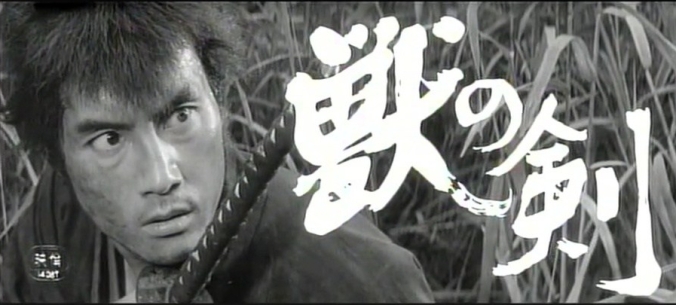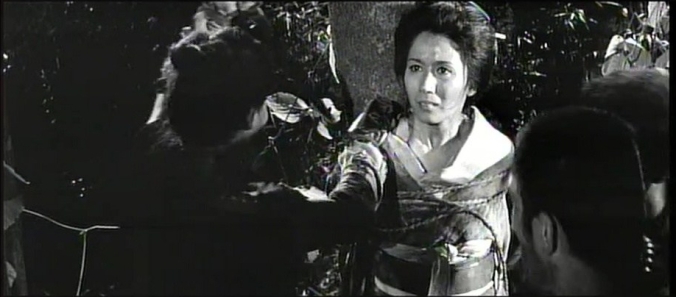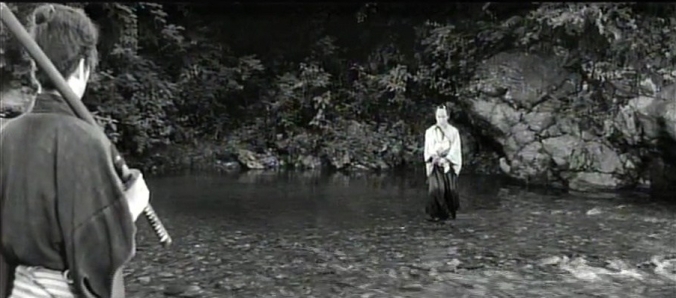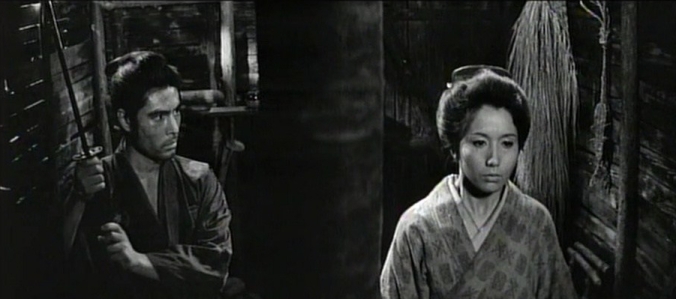
The “beast” at bay
The beast of the title is Yuuki, a samurai on the run after he was duped into killing the chief counselor of his clan. We meet him hiding in the reeds, trying to escape the “vendetta” led by the counselor’s daughter but also including her fiancé and half a dozen or so “helpers,” including of course the best swordsman in the clan’s dojo. Over the course of Yuuki’s various narrow escapes, we learn that he is not a beast at all, but rather a man betrayed by his own clan who has learned that the clan honor and Code he had always believed in was false. As the movie continues, the other people he meets will learn the same lesson. The result is a spectacularly successful chanbara, with plenty of inventive sword-fighting for those who relish it but also a layer of emotion and social criticism that makes it more than a series of fights between good guys and bad guys.
The movie is set in 1857, when everything in Japanese society was beginning to collapse but almost no one had realized it yet. The social codes of the samurai had already collapsed long before, if they ever truly existed at all, and all of that confusion is now bubbling to the surface. After narrow escapes from the vendetta and from wandering bandits, Yuuki finds himself on Japan’s Gold Mountain, the source of the Shogun’s gold where no outsiders are allowed on pain of death. In a secluded cabin he finds a married couple who have been panning gold in secret for years to provide money needed by their clan. Jurata is preparing for the clan consellor to arrive and collect the gold when Yuuki finds them, but he decides to leave them alone. He is followed by a group of bandits who kidnap Jurata’s wife Taka, but Jurata is willing to let her be killed rather than reveal where the gold is hidden and watches silently as Yuuki comes to her rescue. The counselor and his men arrive with orders to get the gold, get off the mountain before the Shogun’s officers can find out about them, and kill everyone who might know about their operation, including Jurata and Taka themselves. This leads to fights among the rocks, water, and forest that make this unusual as well as spectacular.
The counselor and his men arrive with orders to get the gold, get off the mountain before the Shogun’s officers can find out about them, and kill everyone who might know about their operation, including Jurata and Taka themselves. This leads to fights among the rocks, water, and forest that make this unusual as well as spectacular. 
The movie seems to have been shot almost completely on location, first in the reeds like Onibaba and then alongside a mountain river, all photographed in magnificent b&w by Toshitada Tsuchiya (the last of only three movies he made). As if to emphasize the remoteness of Yuuki’s situation, most scenes are accompanied by birds, crickets, or other insect noises I can’t identify, not to mention the constantly rushing water of the river. Like the real and vivid location, the fights are more realistic than usual, though there is very little blood.
In addition to the firm technical control, energy, and pacing by the director Hideo Gosha, two other factors lift the movie out of the ordinary. One is the relationship between Jurata and Taka. As played by Shima Iwashita, it is not Taka’s assault that effectively destroys the marriage but her realization that her husband (a stolid Go Kato) is not the man she thought him to be. It is not so much that he deserts her in her moment of need but that he does it for a nebulous idea of the clan, that he is not only willing to sacrifice years of his life but also hers if necessary, for an idea or an Ideal that when put to the test, fails them. Then, to make it worse, he tries to kill her himself after he sees her talking to Yuuki. He realizes this far too late, only after the clan’s messengers try to kill him, but she sees it much sooner, perhaps has seen it from the very beginning of their trip into the wilderness.
Then, to make it worse, he tries to kill her himself after he sees her talking to Yuuki. He realizes this far too late, only after the clan’s messengers try to kill him, but she sees it much sooner, perhaps has seen it from the very beginning of their trip into the wilderness.
The other unusual aspect is Yuuki himself (Mikijiro Hiro). We have seen many wandering ronin, and many others eking out a living in town waiting to be taken in by some clan, but we have seen few actually “on the run.” Though he is of course a great swordsman, he has learned from his first betrayal that Samurai Honor is merely a shibboleth and that life is more important. Thus, the movie joins the strain of chanbara in the early sixties that began dismantling the myth of the noble samurai and his Code.
It is also just a terrific movie movie. It moves while engaging the audience with sympathetic and well-drawn central characters. The fights grow out of the story, and while they take place in the woods and in the river, none goes on too long just to show off the choreography. The unusual setting is exploited in a variety of ways but never used as scenery for the sake of scenery. Toshiaki Tsushima’s music mixes with the nature noises to striking effect, and Gosha avoids fancy camera work for the sake of fancy camera work. It is not a profound movie, but it is an excellent movie.
Pingback: Samurai Wolf II: Hell Cut / Kiba Okaminosuki Jigoku Giri (1967) | Japanonfilm
Pingback: Samurai Rebellion / Joi-uchi: Hairyo tsuma shimatsu (1967) | Japanonfilm
Pingback: Japan’s Longest Day / Nihon no ichiban naga hi (1967) | Japanonfilm
Pingback: Goyokin (1969) | Japanonfilm
Pingback: One Thousandth Post | Japanonfilm